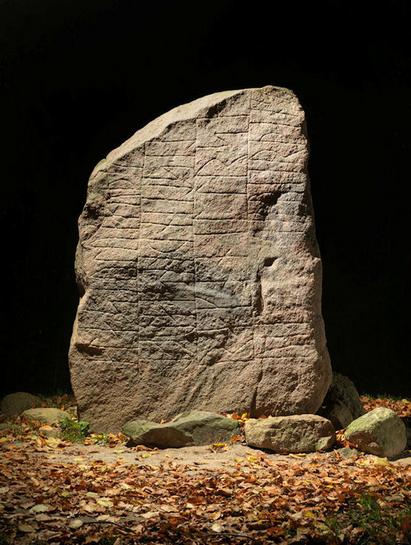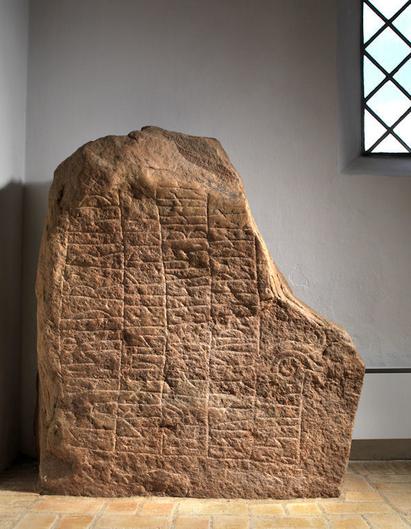Rune stones
The rune stones of the Viking period were erected in memory of the dead – mostly powerful people – and their honourable deeds. They were intended to be visible and were painted in bright colours. The stones often stood near roads or bridges, where many people passed by. They were not necessarily placed at the burial of the person they commemorated.
The rune stones bring us very close to the Vikings. Their inscriptions feature the names of the people who lived and died at this time. They also provide information about the travels, great achievements and sad fates of these individuals.

Rune stones in Scandinavia
Rune stones are by and large only found in Scandinavia. Around 250 rune stones are known from Viking Age Denmark. Most of the Scandinavian examples are from Sweden, where there are over 3000 inscriptions.
The tradition apparently only became widespread in Denmark after Harald Bluetooth erected the large Jelling Stone for his father, Gorm the Old, and his mother, Thyra, around 970. Most of the rune stones in Denmark were raised in the period c. 975-1025.
X raised this stone for Y
The runic inscriptions always name the people who erected the stones and those the stones were raised for. Rune stones were placed in honour of both men and women. Often mentioned are the deceased’s closest kin, position in society, perhaps a short description of his or her character and the circumstances surrounding death. The inscription can also include the rune carver’s name and a curse upon anyone who dares to desecrate the stone. In addition, after the introduction of Christianity, a prayer for the soul of the deceased might be present. Ornamentation and images are also found upon rune stones.

The tradition of erecting rune stones was typically associated with the rich and powerful families of the Viking Age, but was not their exclusive preserve. For example, the Hørning stone, found close to Aarhus, displays an inscription stating that it was erected by an emancipated slave.
Stones that were raised by rich women, often commemorated their husbands. Ragnhild was one such woman. Along with her sons, she erected the rune stone at Glavendrup on Funen. Ragnhildr placed this stone in memory of Alli the Pale, priest of the sanctuary, honourable þegn of the retinue. Alli's sons made this monument in memory of their father, and his wife in memory of her husband. And Sóti carved these runes in memory of his lord…
Many rune stones were erected for Viking warriors. A rune stone from Aarhus is a good example of this. Gunnulfr and Eygautr/Auðgautr and Áslakr and Hrólfr raised this stone in memory of Fúl, their partner, who died when kings fought. The stone was raised as a monument to a comrade-in-arms. The rune stone also displays a depiction of an enormous mask, which may have been added to provide protection against evil spirits.

Sad fates
The texts upon rune stones sometimes also express emotions. An inscription on a stone from Rimsø, which was raised by Thorir in memory of his mother, concludes by stating that a mother’s death is the worst thing that can happen to a son. In addition, a stone at Ålum, in North Jutland, bears the inscription Þyrvé, Végautr's wife, had this stone raised in memory of Þorbjǫrn, son of Sibbi, her sister's son, whom she cared for more than had he been her own son / than a dear son.
Read more about how the Vikings also used runes for magic.
